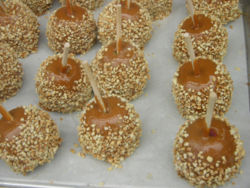This article needs additional citations for verification .(November 2017) |
 Caramel apple with peanuts | |
| Alternative names | Toffee apples, taffy apples |
|---|---|
| Type | Confectionery |
| Place of origin | United States |
| Created by | Hunter's Candy |
| Main ingredients | Apples, caramel, sometimes nuts |
Caramel apples or toffee apples are whole apples covered in a layer of caramel. They are created by dipping or rolling apples-on-a-stick in hot caramel, sometimes then rolling them in nuts or other small savories or confections, and allowing them to cool. When these additional ingredients, such as nut toppings, are added, the caramel apple can be called a taffy apple. [1]

